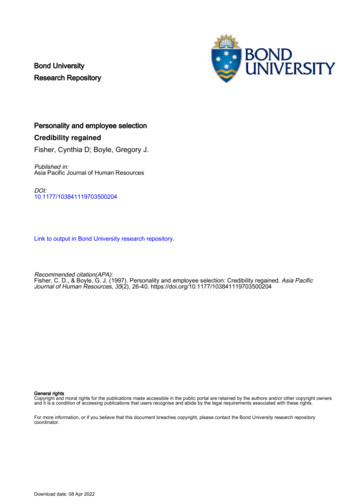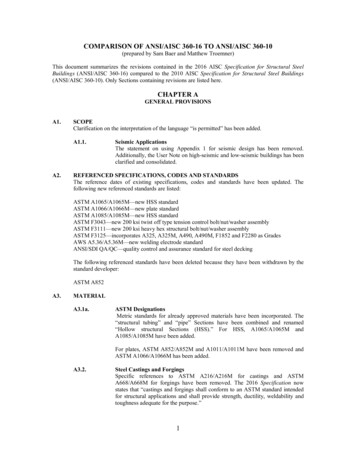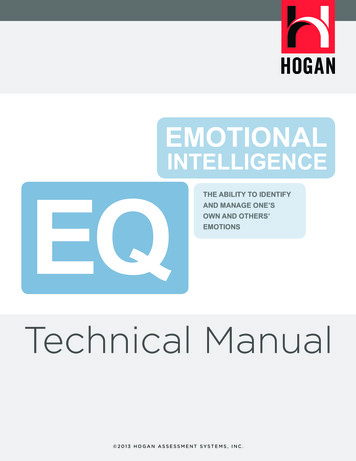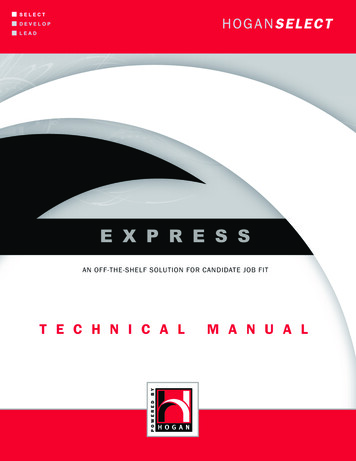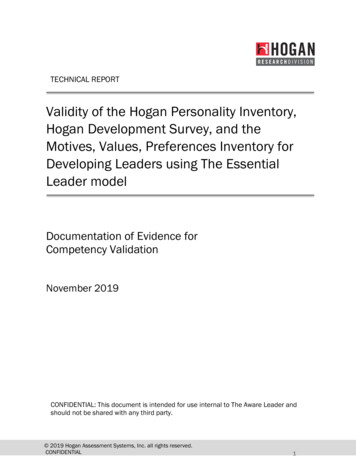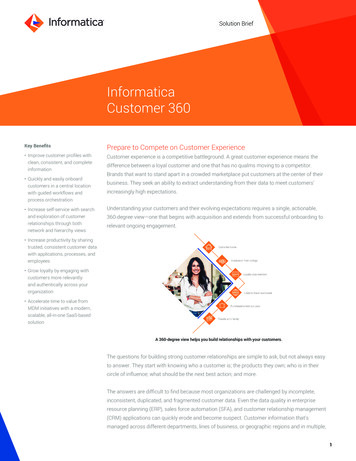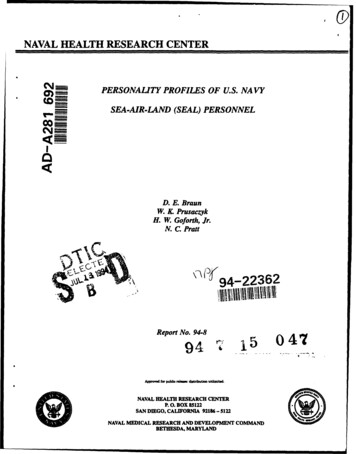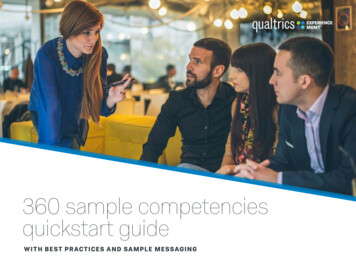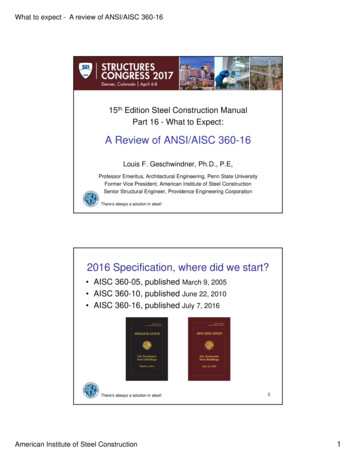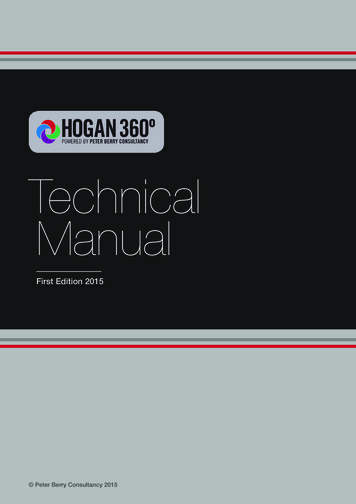
Transcription
TechnicalManualFirst Edition 2015 Peter Berry Consultancy 2015
Hogan 360 Technical ManualFirst EditionPeter Berry ConsultancyHogan Assessment Systems2015 Peter Berry Consultancy 2015
ContentsPage1. Introduction1.1 Applications of the Hogan 360 51.2 The Benefits of Multi-rater Feedback Tools1.3 The Importance of Others’ Perspectives: Socioanalytic Theory677782. Hogan 360 Construction and Reliability91.1.1 Customization of the Hogan 360 1.1.2 Hogan 360 Group Report2.1 Development2.5 Composition of the Hogan 360 : Factor Analysis2.6 Reliability10101111121212131314141415173. Validity183.1 Correlations with Hogan Personality Assessments3.2 Correlations with the Hogan EQ3.3 Criterion Validity: Correlations with Manager Evaluations1929334. Administering the Hogan 360 354.1 Completing the Hogan 360 Online4.2 Participant’s Informed Consent36365. Compilation of Benchmark Data376. References39Appendix A: Hogan 360 Safety ModelAppendix B: Peter Berry’s 9 steps to business excellence (Berry, 2007)Appendix C: Hogan Personality InventoryAppendix D: Hogan Development SurveyAppendix E: Motives Values Preferences Inventory43444546472.1.1 Early Influences2.1.2 Improvements2.2 Leadership Competency Quadrants and Sub-Themes2.2.1 Self-Management2.2.2 Relationship Management2.2.3 Working in the Business2.2.4 Working on the Business2.3 Competency Combinations2.4 Hogan 360 Scoring2.4.1 Overall Hogan 360 Score2.4.2 Leadership Competency Quadrant and Competency Combination Scores
Figures & TablesPageFigure 1The four quadrants of the Hogan 360 Leadership Model.11Figure 2The four leadership competency quadrants and14 leadership sub-themes of the Hogan 360 Leadership Model.11Figure 3The Behavioral Competencies and Business Competenciesof the Hogan 360 Leadership Model.13Figure 4The Management Competencies and LeadershipCompetencies of the Hogan 360 Leadership Model.14Table 1Summary of Principle Component Analysis Results for theHogan 360 (N 7,391)16Table 2Summary of Internal Consistency Analysis Results for theHogan 360 (N 7,391)17Table 3Correlations Between the HPI Scales and the Hogan 360 Leadership Competency Quadrants20Table 4Correlations Between the HPI Scales and the Hogan 360 Leadership Sub-Themes21Table 5Correlations Between the HDS Scales and the Hogan 360 Leadership Competency Quadrants23Table 6Correlations Between the HDS Scales and the Hogan 360 Leadership Sub-Themes24Table 7Correlations Between the MVPI Scales and the Hogan 360 Leadership Competency Quadrants26Table 8Correlations Between the MVPI Scales and the Hogan 360 Leadership Sub-Themes27Table 9Correlations Between the Hogan EQ Components and theHogan 360 Competency Quadrants30Table 10Correlations Between the Hogan EQ Components and theHogan 360 Leadership Sub-Themes31Table 11Correlations Between the Hogan 360 Scores (LeadershipCompetency Quadrant and Overall) and the Manager’sSubjective Evaluations of the Ratee34Table 12Correlations Between the Hogan 360 LeadershipSub-Themes and Manager’s Subjective Evaluationsof the Ratee34Table 13Compulsory and Optional Demographic InformationCaptured for Raters and Ratees38
1Introduction5
IntroductionThe purpose of this technical manual is to outline the theoretical rationale and development of the Hogan 360 powered by Peter Berry Consultancy (hereafter, “Hogan 360 ”), and provide evidence for its reliability and validity.Additionally, this manual provides evidence of the relationships between the Hogan 360 and the Hogan PersonalityInventory (HPI; Hogan & Hogan, 2007), Hogan Development Survey (HDS; Hogan & Hogan, 2009), Motives, Values,Preferences Inventory (MVPI; Hogan & Hogan, 2010), and the Hogan Emotional Quotient (Hogan EQ; HoganAssessment Systems, 2013) assessment. This information will help to enhance the knowledge and application of theHogan 360 by qualified users.The Hogan 360 is a multi-rater instrument designed to measure leadership effectiveness. Leadership is concernedwith the success of teams, groups, and organizations (Hogan & Kaiser, 2005). Hogan, Curphy, and Hogan (1994)identified five categories of leadership effectiveness research, one of which is through direct reports’, peers’ andsupervisors’ ratings. Therefore, leadership effectiveness can be measured by how positively a leader’s behaviors andperformance are evaluated by those they work with. The multi-rater aspect of the Hogan 360 ensures evaluations areelicited from multiple sources from within the leader’s work circle (e.g., from direct reports, peers, and managers).These diverse perspectives help provide a real-time snapshot of a leader’s attitude, behavior, and performance,and reveal strengths and development opportunities that may not be seen from a single perspective. Further,due to the confidential and anonymous nature of the responses, the Hogan 360 allows raters to provide honestfeedback that might otherwise be difficult to solicit. The report uses an easy-to-interpret leadership framework, offersconstructive feedback and sets priorities for improvement. Therefore, the Hogan 360 aims to help leaders at anylevel of an organization gain a better understanding of how they are truly perceived by others and improve theirleadership potential.The Hogan 360 is a multi-rater instrument designed tomeasure leadership effectiveness.1.1 Applications of the Hogan 360 Consistent with all Hogan assessments, the Hogan 360 is specifically designed and validated for use within workingpopulations. Applications of the Hogan 360 include:Leadership developmentCareer developmentTalent identificationTalent developmentTeam buildingSuccession planningMonitoring organizationalchangeThe Hogan 360 can also be used at various levels of an organization, for example:For senior managersas part of an executivedevelopment programand/or one-on-onecoachingFor middle managersas part of a managementdevelopment programand/or one-on-onecoachingFor emerging leadersas part of a talentdevelopment programand/or one-on-onecoachingFor individuals on one-offassignments where thereis a particular need tounderstand how they areperceived by co-workers6
IntroductionAlthough the report is useful alone, it is much more effective to combine the Hogan 360 behavioral ratings withresults from other assessments. Providing additional sources of information helps increase the depth and breadthof an individual’s awareness and enhances the impact of the results. For example, researchers at Peter BerryConsultancy (PBC) examined the relationship between personality and multi-rater results. Their results showconsistent patterns in score differences obtained on the Hogan 360 in line with variability on aligned personalitytraits (Caplinger & Gaddis, 2012).For many leaders, the Hogan 360 process is not a one off event. The Hogan 360 can be re-administered oncethe individual has had sufficient time to make changes (e.g., 12 months). A comparison of the initial and subsequentscores can help to identify and track changes in behavior and performance.1.1.1 Customization of the Hogan 360 The Hogan 360 is a versatile tool that can be customized to meet any organization’s needs. For example, additionalitems can be added to the Hogan 360 to measure organization specific competencies not already captured by theHogan 360 . In addition to organization specific customizations, various off-the-shelf Hogan 360 solutions exist,such as the Hogan 360 Safety, which includes 10 additional items assessing Safety Leadership (see Appendix A).1.1.2 Hogan 360 Group ReportIndividual Hogan 360 results can also be combined to create a Hogan 360 group report. This captures data frommultiple individuals and generates scores for the group to highlight group-level strengths and opportunities. Thesegroups of individuals may represent a team, cohort, or organization. The Hogan 360 group report is useful for groupanalysis, organizational analysis, and comparing the individual to the group.1.2 The Benefits of Multi-rater Feedback ToolsThere are two main benefits of multi-rater feedback tools. First, as mentioned, it provides a measurement of aleader’s effectiveness, and research into multi-rater feedback ratings has demonstrated links to a variety of importantorganizational outcomes. For example, Smither, London, and Reilly (2005) found positive relationships betweenmulti-rater feedback ratings and profit, store outcomes, level of sales, service quality, and subordinate (i.e., directreport) satisfaction and engagement. They also found negative relationships between multi-rater feedback ratingsand both turnover intentions and actual turnover. Hezlett (2008) reported positive linkages between leadershipdevelopment associated with multi-rater feedback and subsequent increases in customer loyalty, revenue, employeejob satisfaction, employee engagement, and employee intentions to stay. In terms of overall performance, seniormanagers identified as high performers were more likely to receive higher multi-rater feedback ratings than thoseclassified as below average performers (Church, 2000).Second, results from multi-rater feedback tools can provide the foundations for development. The results canhelp pinpoint the strengths and opportunities, which can then be used to formulate targeted strategies forimprovement. The evidence for improving performance via deliberate practice is abundant (e.g. Ericsson, Krampe,& Tesch-Romer, 1993; Nonis & Hudson, 2010; Sonnentag & Kleine, 2000). Evidence of leadership effectivenessimprovement, following participation in multi-rater feedback processes, also exists. Thach (2002) for example, foundthat the combination of multi-rater feedback and individual coaching resulted in an increase of up to 60 per centin leadership effectiveness. However, there are significant variations across studies in terms of the degree to whichmanagers improve after multi-rater feedback (Hezlett, 2008). Smither et al. (2005) suggest that this may be due tothe lack of consistency across multi-rater instruments used in organizations. The amount of focused developmenteffort that is committed by managers post multi-rater feedback is also highly variable. These inconsistent findingshighlight the importance of using a multi-rater tool with sound reliability and validity, as well as a consistent and bestpractice approach to administering the tool.7
IntroductionThe Hogan 360 is a versatile tool that can be customized to meet anyorganization’s needs.1.3 The Importance of Others’ Perspectives: Socioanalytic TheoryVarious studies have shown that perceptions of one’s own performance and behavior can differ greatly comparedto how others perceive them (Conway & Huffcutt, 1997; Harris & Shaubroeck, 1988; Heidemeier & Moser, 2009).This suggests that individuals often lack self-awareness with regard to how others see them and underscoresthe importance of multi-source feedback for those in leadership positions. The socioanalytic theory of personalityhighlights the distinction between the actor and observers’ perspectives, with an emphasis on the latter.Socioanalytic theory aims to explain individual differences in interpersonal effectiveness and why people interact asthey do (Hogan, 1982, 1991, 1996). It can also be used to explain individual differences in people’s performance atwork (Hogan & Holland, 2003).Grounded in the long tradition of interpersonal psychology (Carson, 1969; Leary, 1957; Sullivan, 1953; Wiggins,1979), socioanalytic theory is based on two generalizations relevant to organizational behavior; people always live(work) in groups, and groups are always structured in terms of status hierarchies. These generalizations suggest thepresence of two broad motive patterns. These patterns translate into behavior designed to “get along” with othermembers of the group and “get ahead” or achieve status in the group; familiar themes in personality psychology(cf. Adler, 1939; Bakan, 1966; Rank, 1945; Wiggins & Trapnell, 1996). Individual differences in the ability to getalong and get ahead translate into individual differences in career success.Socioanalytic theory also specifies that personality should be defined from the perspectives of the actor andthe observer. Personality from the actor’s view is a person’s identity, which is defined in terms of the strategies aperson uses to achieve acceptance and status. Identity controls an actor’s social behavior. Personality from theobserver’s view is a person’s reputation, and it is defined in terms of trait evaluations— conforming, helpful, talkative,competitive, calm, curious, and so forth. Reputation reflects the observer’s view of an actor’s characteristic waysof behaving in public. Reputation is the link between the actor’s efforts to achieve acceptance and status and howthose efforts are evaluated by observers. Reputation describes a person’s behavior; identity explains it.Reputation reflects the observer’s view of an actor’s characteristicways of behaving in public.Multi-rater tools like the Hogan 360 capture reputation. This provides a snapshot of how others perceive anindividual’s performance and behavior. The multiple sources used in multi-rater feedback initiatives help obtain anuanced and comprehensive understanding of that individual’s behavior in the workplace (Aguinis, 2013). Therefore,multi-rater feedback tools provide useful information about behaviors that are outside of one’s awareness.8
2Hogan 360 Construction& Reliability9
Hogan 360 Construction and Reliability2.1 Development2.1.1 Early InfluencesThe design and development of the Hogan 360 began at Peter Berry Consultancy (PBC) in the early 1990s. Theaim was to develop a business focused multi-rater feedback tool that measured and could be used to improveleadership effectiveness. Four major influences on the initial framework of the Hogan 360 were the Baldrige Criteriafor Performance Excellence (Baldrige model; National Institute of Standards and Technology, 1988), the BalancedScorecard (Kaplan & Norton, 1996), the collective literature on emotional intelligence, and the collective literatureon employee engagement. The Baldrige model, supplemented by the Balanced Scorecard, provided a frameworkto inform the development of business-related competencies, while the emotional intelligence and employeeengagement literature provided a framework to inform the development of behavioral competencies.We selected the Baldrige model as the framework for the Hogan 360 based on its ability to predict organizationalperformance outcomes (Flynn & Saladin, 2001; Ghosh, Handfield, Kannan, & Tan, 2003; Lee, Rho, & Lee, 2003).The criteria revolutionized standards on quality and continue to be used internationally as a guide for businessstrategy development. It is a continuous improvement framework that covers seven dimensions critical toperformance excellence, including leadership, planning, customers, measurement, people, processes, and results.The Balanced Scorecard was also a significant influence on the development of the Hogan 360 . Kaplan andNorton’s (1996) innovation was the establishment of non-financial measures alongside financial ones as a basisfor strategic planning, measurement and continuous improvement. Although the Balanced Scorecard started as ameasurement tool, it has since evolved into a strategic planning framework covering financials, customers, internalbusiness processes, and learning and growth.Despite the advantages of both the Baldrige model and the Balanced Scorecard, the Baldrige model is usedas the organizing framework for the Hogan 360 due to its emphasis on leadership, people, and culture. Usingthe Baldrige model as the theoretical foundation, and the Balanced Scorecard to supplement the model, PBCdeveloped its own “9 Steps to Business Excellence” (see Appendix B; Berry, 2007) and began work on theHogan 360 . In its early format, the Hogan 360 items were designed to assess leadership, strategic planning,measurement, people, customers, processes and performance. The first version of the Hogan 360 was releasedin 1995.That same year, the concept of emotional intelligence was popularized with the publication of DanielGoleman’s Emotional Intelligence – Why it can matter more than IQ (1995). Goleman’s book emphasized theimportance of social and emotional competence, which aligns with the idea of “getting along” to “get ahead”,a fundamental concept in socioanalytic theory (Hogan, 1982). It became obvious that social and emotionalcompetencies (behavioral competencies) needed to be captured by a multi-rater tool if it was to measure trueleadership effectiveness.In addition, leadership behavior and its impact on employee engagement had become a key area for organizationalresearch (e.g. Babcock-Roberson & Strickland, 2010; Macey & Schneider, 2008; Piccolo & Colquitt, 2005; Tims,Bakker, & Xanthopoulou, 2011). Given the ability of employee engagement metrics to predict a variety of importantorganizational outcomes (e.g. Alarcon & Edwards, 2011; Harter, Schmidt, & Hayes, 2002; Kompaso & Sridevi, 2010;Rich, Lepine, & Crawford, 2010; Sorenson, 2013), the need to include behavioral measures of leadership becamemore apparent. To address this, PBC examined several thousand employee opinion survey responses to informemployee engagement related items for the Hogan 360 .Based on this collective evidence, PBC developed a four quadrant leadership model that captures both businessand behavioral competencies, illustrated in Figure 1. The original Hogan 360 items that used the Baldrige modelas the theoretical foundation are captured in the Working in the Business and Working on the Business quadrants.Encompassing Self-Management and Relationship Management, the top half of the quadrant focuses on anindividual’s intra- and inter-personal skills (i.e., the behavioral competencies needed to get along and get ahead),while the bottom half of the quadrant focuses on the leader’s operational (Working in the Business) and strategic(Working on the Business) competencies. The model, therefore, captures both soft and hard skills.10
Hogan 360 Construction and ReliabilitySelf-ManagementRelationship ManagementLeadership ModelWorking in the BusinessWorking on the BusinessFigure 1. The four quadrants of the Hogan 360 Leadership Model.This model was confirmed in discussions with Dr Robert Hogan in 2010 – PBC had become the Australiandistributor for Hogan Assessment Systems in 2002. It was agreed that the model represented a comprehensive,generic and global set of competencies that allowed the measurement of a leader’s performance and behavior.2.1.2 ImprovementsThe first enhancement to the Hogan 360 was the inclusion of open-ended questions. In its earliest form, theHogan 360 consisted only of scaled items. To enrich feedback, we added two open-ended questions focusingon strengths and opportunities. By 2004, PBC had collected over 30,000 open text responses around strengthsand opportunities. We conducted qualitative thematic analysis to identify common themes from the open-textitems. We identified the 26 strengths and 26 development opportunities most commonly cited in the open-endedresponses. Based on this analysis, current Hogan 360 users are asked to pick four strengths and four developmentopportunities, and choices are allocated points that help affirm strengths and development opportunities. In 2011,we added a third open-ended item focusing on overused strengths. This addition helps capture descriptions ofdysfunctional behaviors and derailment tendencies measured by the Hogan Development Survey.In its current form, the Hogan 360 includes: 50 scaled items (7-point scale) mapped to the four quadrants of the Hogan 360 Leadership Model and theircorresponding sub-themes A strengths and opportunities table that identifies four key strengths and four key opportunities Three open-ended questions focusing on strengths, opportunities, and overused strengths2.2 Leadership Competency Quadrants and Sub-ThemesThe Hogan 360 Leadership Model consists of four leadership competency quadrants: Self-Management,Relationship Management, Working in the Business, and Working on the Business. Each quadrant of the modelis comprised of sub-themes to allow for greater interpretive power. Figure 2 displays the Hogan 360 LeadershipModel, and its competency quadrants and sub-themes.Leadership ModelSelf-Management Integrity ResilienceRelationship Management Communication People Skills Team player CustomerWorking in the Business Capability Efficiency Results EngagingWorking on the Business Accountability Motivation Strategy InnovationFigure 2. The four leadership competency quadrants and 14 leadership sub-themes of the Hogan 360 Leadership Model.11
Hogan 360 Construction and Reliability2.2.1 Self-ManagementSelf-Management refers to personal awareness, self-regulation, stress management, resilience, transparency,and authenticity. It describes the process of managing one’s emotions maturely to achieve the best outcomes. Itmay require positive self-talk and recovery periods to fuel peak performance in turbulent times and avoid burnout.Successful self-management requires management of the self and taking care of one’s brand and reputation. SelfManagement consists of the sub-themes Integrity and Resilience:IntegrityServes as a role model for the organization’s values in relation to treating employeeswith respect and equityResilienceMaintains emotional maturity even in stressful situations and spends time reflectingabout personal improvement opportunities2.2.2 Relationship ManagementRelationship Management refers to the ability to achieve better results through better relationships. It is about gettingalong with others in order to get ahead. It can involve the ability to build trusting, loyal relationships with stakeholdersto support retention and performance. Relationship Management consists of the sub-themes Communication,People Skills, Team Player, and Customer:CommunicationHas clarity and professionalism in communication style and messagePeople SkillsEngages with others and is approachable and authenticTeam PlayerActively builds team functionality and cohesionCustomerIs driven by internal and external customer needs to drive improvement2.2.3 Working in the BusinessWorking in the Business refers to having the experience, capability, and efficiency to consistently deliver greatresults. It requires having the energy, passion, and competitive drive to stay in the performance zone. Success in thisarea can involve smarter prioritization of work, more delegation, better time management, and more effective goalsetting. It is about achieving service and operational excellence in a timely, efficient manner. Working in the Businessconsists of the sub-themes Capability, Efficiency, Results, and Engaging:CapabilityHas the requisite ability and experience to do one’s current roleEfficiencyPrioritizes and manages time and effort for maximum benefitResultsDelivers on commitments and expectations to a high standardEngagingBrings positive energy to the workplace12
Hogan 360 Construction and Reliability2.2.4 Working on the BusinessWorking on the Business refers to adding extra value through innovation and strategic planning and buildingmotivated, accountable teams. Success in this area can involve long-term planning to achieve competitiveadvantage and delivering results through high-performing cultures. Leading change requires spending more timeon the business, having a planning cycle, conducting regular planning reviews, and challenging poor performers.Working on the Business consists of the sub-themes Accountability, Motivation, Strategy, and Innovation:AccountabilityManages performance by providing consistent and constructive feedbackMotivationCreates a work environment that allows everyone to become engagedStrategySpends time thinking long term and shares vision with othersInnovationSuggests and supports ideas that improve processes and deliverables2.3 Competency CombinationsCompetency quadrants of the Hogan 360 Leadership Model can be combined to provide greater depth ofinterpretation, thereby assisting individuals with identifying targeted developmental opportunities. Hogan 360 scores from the Self-Management and Relationship Management quadrants are combined to form the BehavioralCompetencies. The Behavioral Competencies combination is an indicator of an individual’s propensity toprofessionally manage oneself and relate appropriately to others. The Working in the Business and Working onthe Business quadrants of the Hogan 360 are combined to form the Business Competencies. The BusinessCompetencies combination is an indicator of an individual’s propensity to deliver and optimize day-to-day andlonger-term results. These combinations are described in more detail in Figure 3.Self-ManagementRelationship ManagementBehavioral CompetenciesThe Behavioral Competencies combination describes the use of emotional intelligence (EQ) to professionally manageoneself and relate appropriately to others to get the best outcomes from teams and stakeholders. High scorers typicallydemonstrate emotional resilience and strong interpersonal skills to improve results through better relationships. It requiresstable, sustainable relationships to stay in the performance zone and avoid derailment.Working in the BusinessWorking on the BusinessBusiness CompetenciesThe Business Competencies combination describes the use of cognitive capability (IQ) to get the right balance betweenworking in (operational) and on (strategic) the business to optimize day-to-day and longer-term results. High scorerstypically demonstrate both the technical ability to deliver service and operational excellence as well as strategic insightto drive the bigger picture. It requires a strategic focus to deliver great results through high-performing cultures.Figure 3. The Behavioral Competencies and Business Competencies of the Hogan 360 Leadership Model.13
Hogan 360 Construction and ReliabilityThe combined scores from the Self-Management and Working in the Business components form ManagementCompetencies. The Management Competencies combination is an indicator of an individual’s propensity to selfregulate and deliver day-to-day results. The combined scores for the Relationship Management and Working onthe Business components of the Hogan 360 form the Leadership Competencies. The Leadership Competenciescombination is an indicator of an individual’s propensity to build and maintain relationships to drive a strategicagenda. These combinations are described further in Figure 4.Self-ManagementWorking in the BusinessLeadership CompetenciesThe Leadership Competencies combination describes thebigger-picture world of the leader who makes time to createstakeholder engagement around strategic goals. High scorerstypically build trusting, loyal relationships and motivate othersto achieve the strategic agenda. It is about partnershipsdelivering innovation and peak performance.Management CompetenciesThe Management Competencies combination describes theworld of the day-to-day manager where integrity and resilienceare required to maximize capability, efficiency, and positivityto deliver sound results. High scorers typically achieve serviceand operational excellence in a timely and efficient manner andare held accountable for performance by measurement.Relationship ManagementWorking on the BusinessFigure 4. The Management Competencies and Leadership Competencies of the Hogan 360 Leadership Model.2.4 Hogan 360 ScoringThe Hogan 360 consists of 50 items that are used for scoring. Each item is scored on a 7-point scale (1 Does notdescribe this person at all, 7 Describes this person exactly), with a Not Applicable option available. On the report,overall and rater group averages (e.g., manager, peer, and direct report) are provided for each item.2.4.1 Overall Hogan 360 ScoreThe ratee’s overall Hogan 360 score is calculated by averaging all ratings across the 50 items, yielding an overallHogan 360 score between 1.00 and 7.00. This overall score is compared to a benchmark sample which is updatedannually. The sample is comprised of leaders and executives that represent the international working populationacross a broad number of industries (see Section 5 for a description of the Hogan 360 benchmark sample). Thecomparison between an individual’s overall score and the benchmark mean yields a percentile ranking that allowsleaders to gauge their performance in relation to others around the world.2.4.2 Leadership Competency Quadrant and Competency Combination ScoresAs the 50 items are grouped into the four leadership competency quadrants and their respective sub-themes, anaverage score for each leadership competency quadrant and sub-theme can be derived. Competency combinationscores are derived by averaging the scores of items that fall under each combination of leadership competencies.14
Hogan 360 Construction and Reliability2.5 Composition of the Hogan 360 : Factor AnalysisWe conducted a principal components analysis (PCA) to better understand the relationships between items andscales and account for the variances between the Hogan 360 items using the fewest number of “factor” variables.Based on the theoretical background upon which the Hogan 360 was developed, it was hypothesized that fourfactors would emerge to represent the four leadership competencies. The analysis was conducted using all raterdata (N 7,391) from Hogan 360s completed in 2012 and 2013, and reflected Hogan 360 scores for a total of667 leaders.We conducted a PCA with pairwise exclusion and oblique rotation (Promax, kappa 1). We chose oblique rotationbecause the four leadership competencies can be interpreted in combinations (e.g., Self-Management andRelationship Management can be interpreted together as Behavioral competencies). The combination interpretationswould imply that s
powered by Peter Berry Consultancy (hereafter, “Hogan 360 ”), and provide evidence for its reliability and validity. Additionally, this manual provides evidence of the relationships between the Hogan 360 and the Hogan Personality Inventory (HPI; Hogan & Hogan, 2007), Hogan Development Survey (HDS; Hogan
